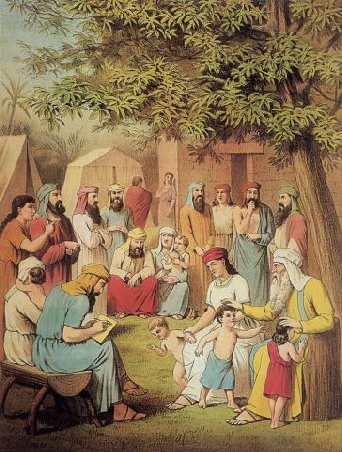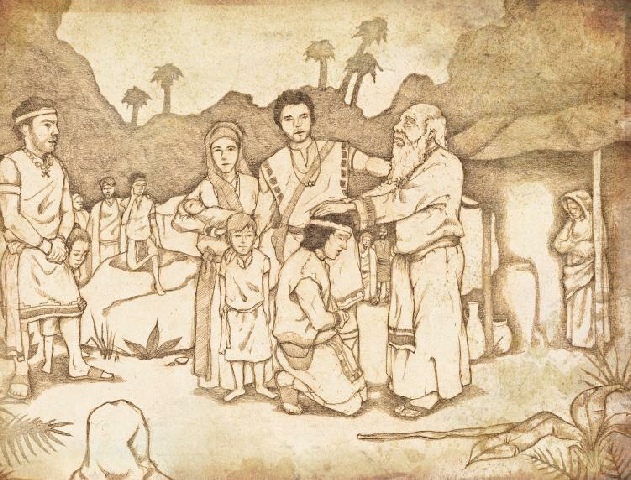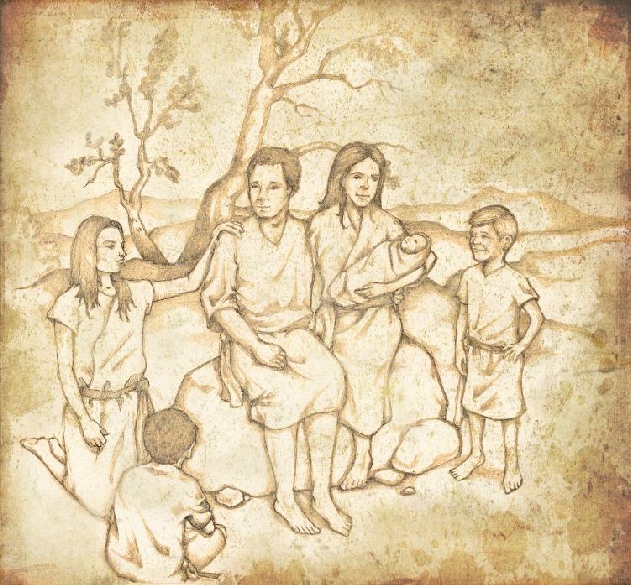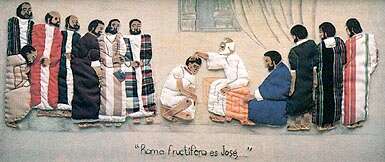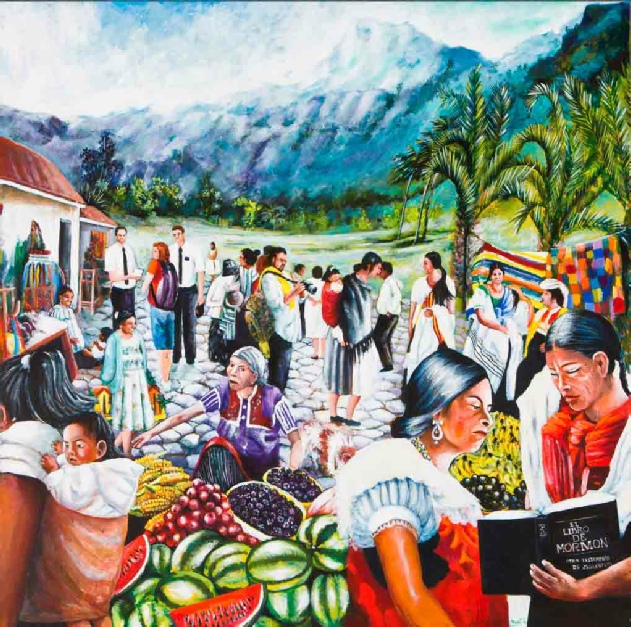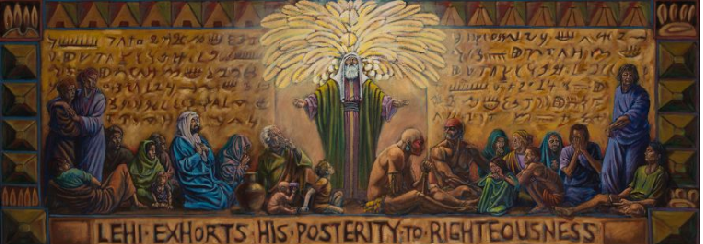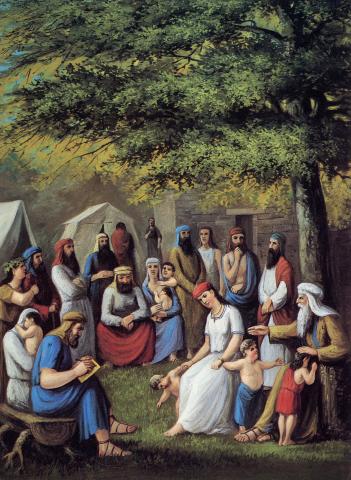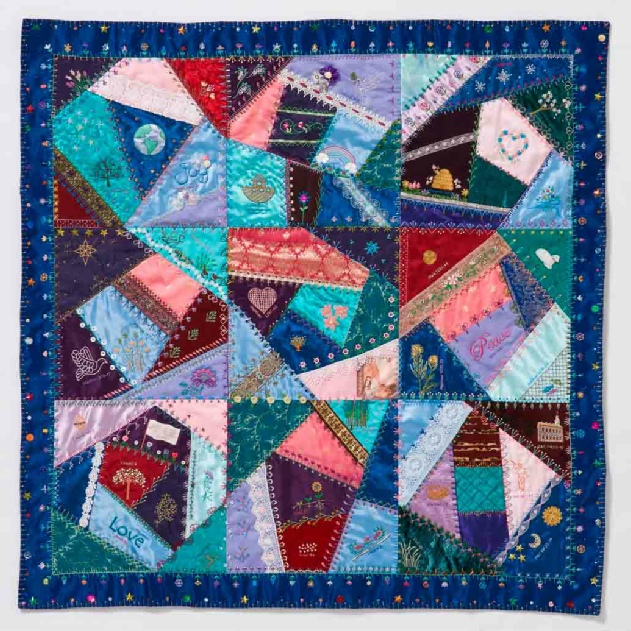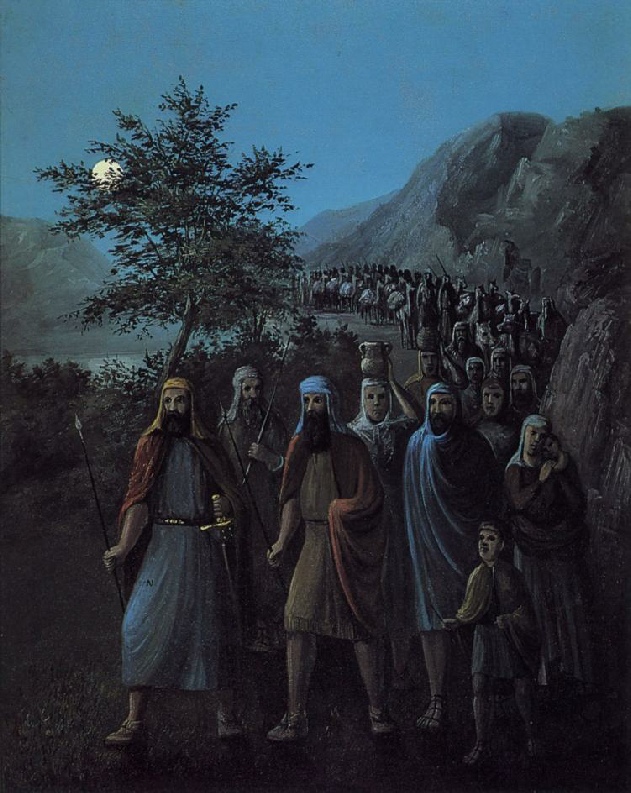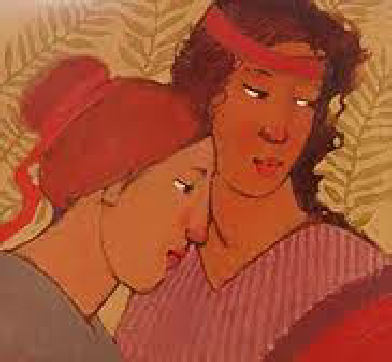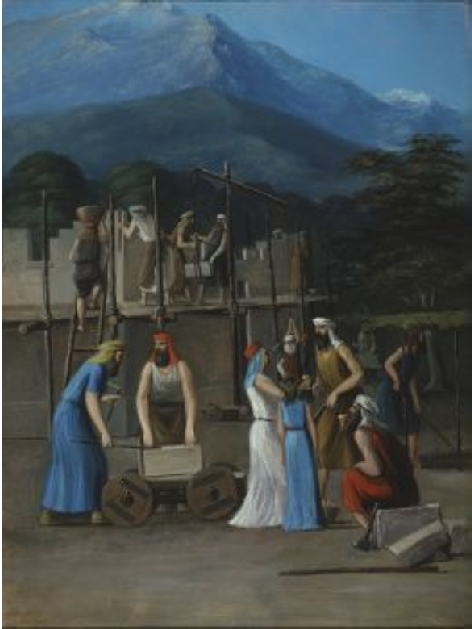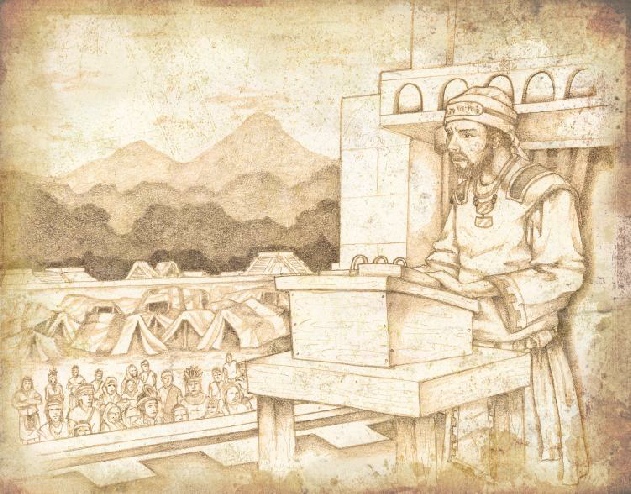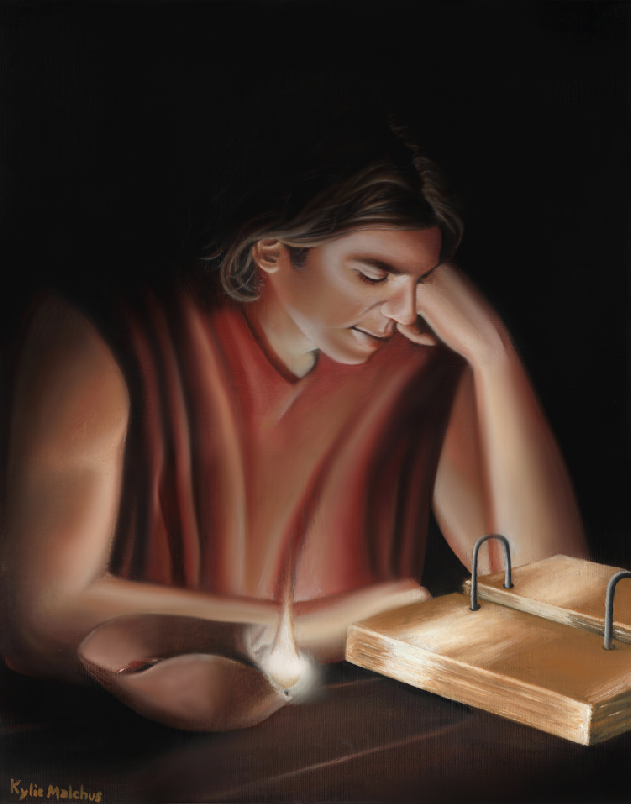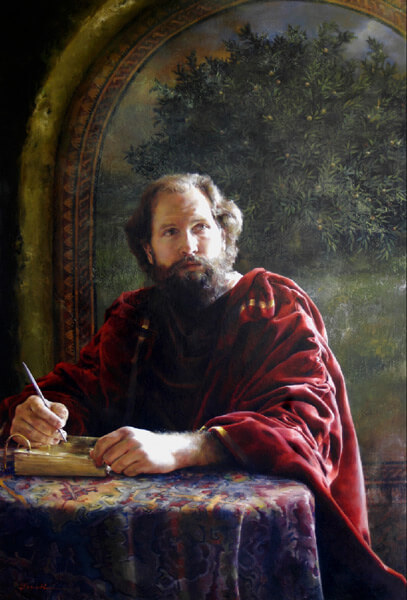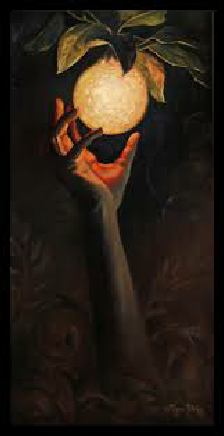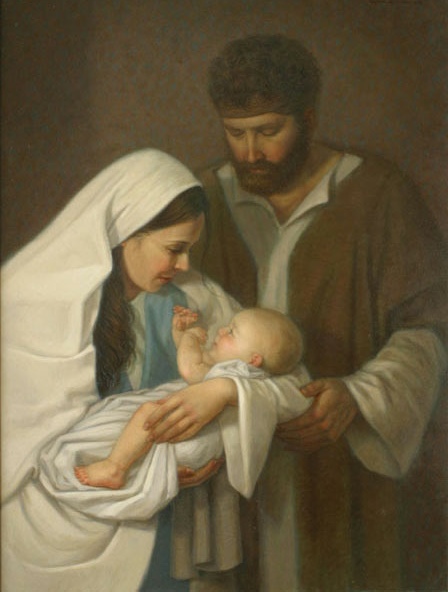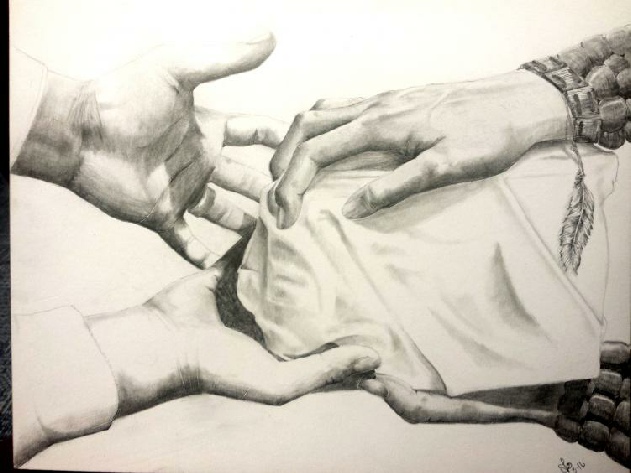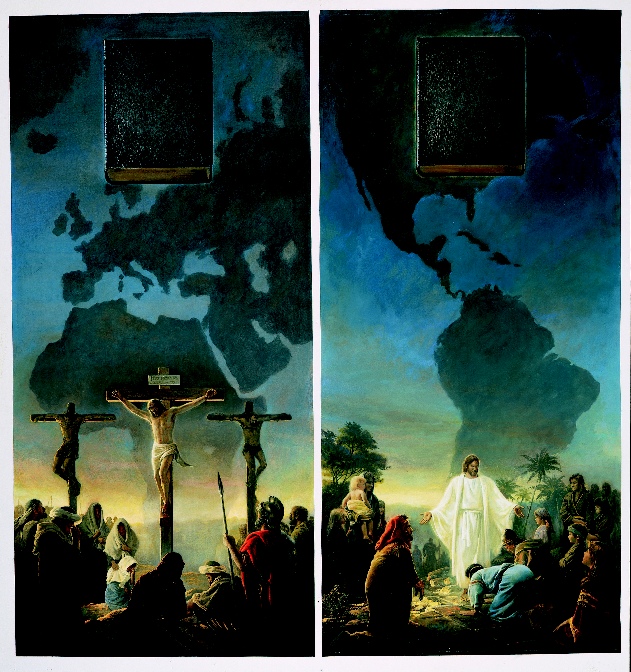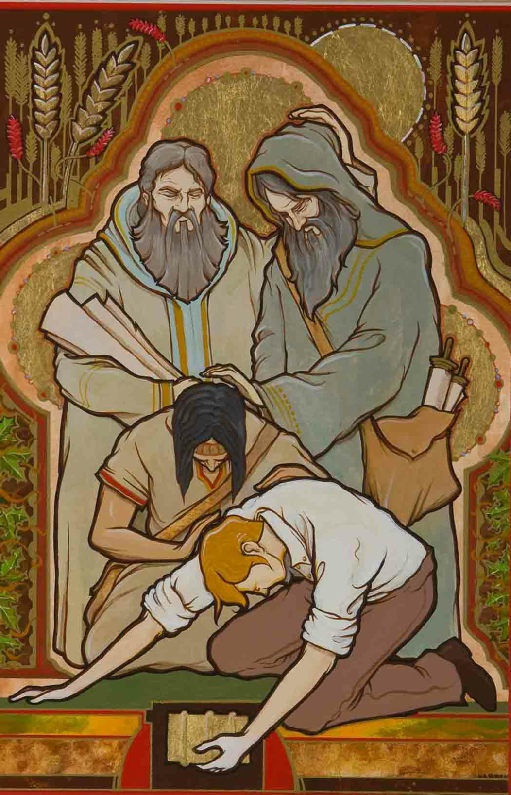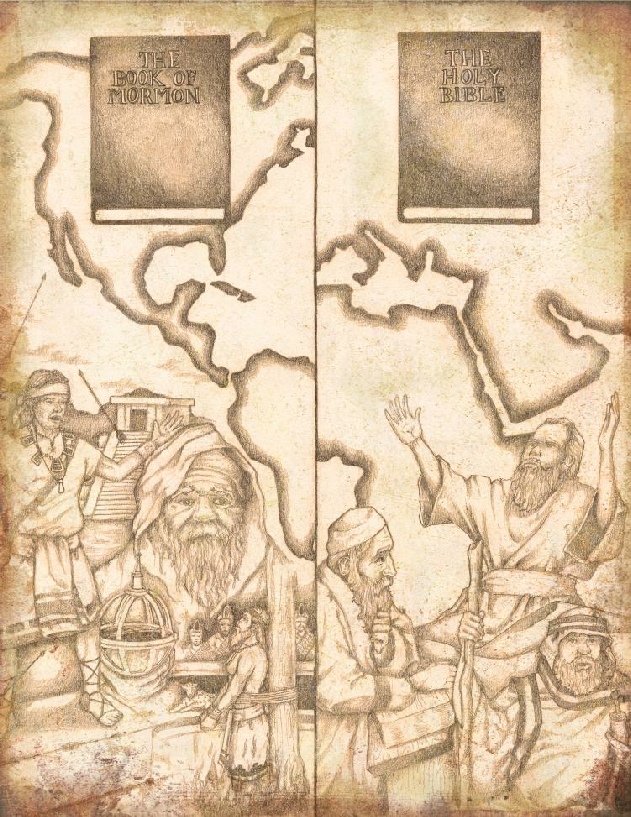






Book of Mormon Feast
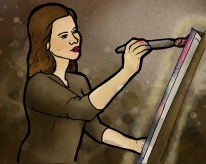
An Artistic Tour of 2 Nephi
2 Nephi 1 – 4
BOOK OF MORMON MUSIC
“My Father, Great Lehi” -
Sacred Hymns of the Book of Mormon, 3
Nephi, who began the Book of Mormon record, wrote of his own experiences as a young, developing son of the prophet Lehi. He quoted his father extensively, and particularly Lehi’s last words to his posterity, individually and collectively.
My father, great Lehi, my father -
He taught me by word and example of sacred things precious and dear.
The Lord spoke and Lehi consented; he gave up his wealth and his lands
To live in remote isolation, no more to see home place and friends.
2 Nephi 1:28
BOOK OF MORMON ART
Jody Livingston
2 Nephi 2:20
BOOK OF MORMON ART
Adam and Eve with Their Children
Jody Livingston
2 Nephi 2:25
BOOK OF MORMON MUSIC
“Men Are That They Might Have Joy” – J. Marinus Jensen & J.J. Keeler
LDS Hymns, 275
Book of Mormon prophet Lehi, whose life spanned a variety of problems, disappointments, and suffering, gave the world a timeless adage when he said, “Adam fell that men might be, and men are that they might have joy.”
2 Nephi 3:4
BOOK OF MORMON ART
Isa Tania Domínguez Herrada
Detail from quilt, by Isa Tania Domínguez Herrada, Xochimilco Ward, México City México Tlalpan Stake.
“Joseph is a fruitful bough, even a fruitful bough by a well; whose branches run over the wall. … The blessings of thy father … shall be on the head of Joseph, and on the crown of the head of him that was separate from his brethren” (Gen. 49:22, 26). The Nephites and Lamanites, descendants of Joseph, are beneficiaries of the blessings sealed upon the head of Joseph.
2 Nephi 3:23
Susana Elcira Bustos Martinez
oil on canvas
The missionaries extend the message of the Book of Mormon to all the world. The Lord said that we are to “go into all the world to preach my gospel unto every creature” (D&C 18:28). In the midst of the noise and tasks of daily life, the gospel message is transmitted through the work of the missionaries. This artwork depicts daily life in Mesoamerica. Dressed in typical Guatemalan clothing, two women read the Book of Mormon. A vendor of roasted corn takes no notice of the women, nor of the missionaries behind her giving a Book of Mormon to a tourist. A woman who tends to stay in the background observes them with curiosity. In the background, the mountains appear as a goal to be reached, symbolizing the divine, set apart from the earthly.
2 Nephi 4:4
BOOK OF MORMON ART
Lehi Exhorts His Posterity to Righteousness
Philip Leaning
Oil on canvas, 1999
2 Nephi 4:11
BOOK OF MORMON ART
Lehi Blessing His Posterity/Family
C.C.A. Christensen
Shortly before his death, Lehi called his posterity together and gave them final exhortations and blessings.
The contrast between this painting and the subsequent lithograph helps make clear
some of Christensen's style in painting people. The lithograph, which is a redrawing
of Christensen's original, shows greater drawing skill. But it also shows the weakness
of the academic tradition in depicting life. Contrast the three small children closest
to Lehi in the lower right. The little girl is Christensen's painting is burying
her face in her grandfather's lap. In the lithograph she is primly standing in a
graceful pose. The chubby little boy in the blue skirt standing flat-
2 Nephi 4:15
BOOK OF MORMON QUILT
My Soul Delighteth in the Scriptures
Patricia Welch
fabric crazy quilt
Selected patches in this quilt represent scriptures that teach gospel principles that are meaningful to me. The quilt was inspired by the testimony and example of Nephi, who made such great efforts to ensure that his people would have a record of the word of God and know His works. Nephi’s love of the scriptures and powerful testimony touch the hearts of many and inspire us to read and study the scriptures and apply God’s plan to our lives. “For my soul delighteth in the scriptures, and my heart pondereth them, and writeth them for the learning and the profit of my children” (2 Nephi 4:15).
2 Nephi 4:15
BOOK OF MORMON ART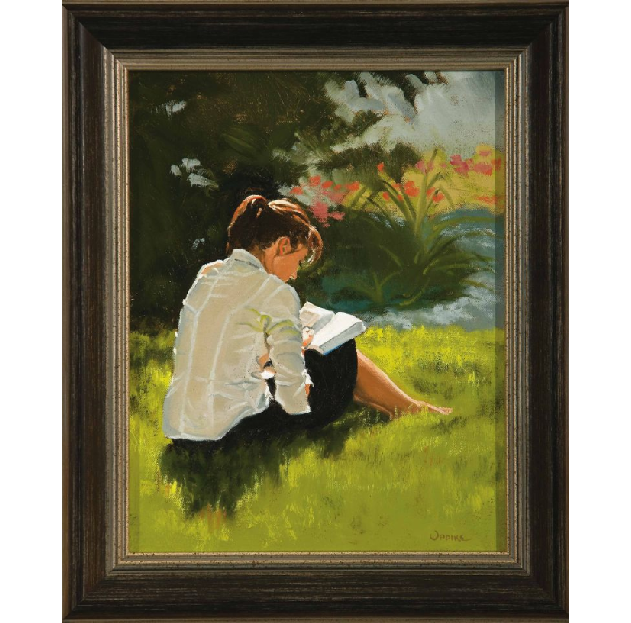
My Soul Delighteth in the Scriptures
Carl Updike
oil on canvas, 2008
2 Nephi 4:15
BOOK OF MORMON MUSIC
“The Books in the Book of Mormon” – Children’s Songbook, 119
Three different prophets named Nephi have resulted in four books in the Book of Mormon with this name.
Family Gal presents a fun, hand-
2 Nephi 4:16-
BOOK OF MORMON MUSIC
“Nephi’s Psalm” -
Sacred Hymns of the Book of Mormon, 5
The section of the Book of Mormon referred to as “Nephi’s Psalm” is a heartfelt expression of prayer, dense with life lessons and yearning.
2 Nephi 5:5
BOOK OF MORMON ART
The Separation of the Nephites and Lamanites
C.C.A. Christensen
Nephi's brothers plotted to kill him, saying that he wished to rule over them. Like his father before him, Nephi was warned by the Lord to flee with his family and followers into the wilderness.
Nephi, front left, leads his people in this nighttime march. The clothing style is very similar to the classical styles that Christensen would have seen at the Royal Academy and in European religious painting.
2 Nephi 5:6
BOOK OF MORMON ART
Kathleen Peterson
2 Nephi 5:16
BOOK OF MORMON ART
C.C.A. Christensen
Oil on board
2 Nephi 6:1
BOOK OF MORMON ART
Jody Livingston
2 Nephi 11:2
BOOK OF MORMON ART
My Soul Delighteth in the Words of Isaiah
This is my depiction of Nephi studying Isaiah out of the brass plates. In order for
Nephi to have such a unique understanding of Isaiah's prophesies, he must have dedicated
countless hours to studying, pondering, and praying about his words. I like to imagine
he studied by night, perhaps the only free time he had in the midst of journeying
in the wilderness, hunting, and ship building. I depicted Nephi reading by the light
of an Iron-
2 Nephi 11:2,3
BOOK OF MORMON ART
“I Will Send Their Words Forth {Jacob}.”
Elspeth Young
Artist’s Comments:
The story behind I Will Send Their Words Forth
Nephi, the son of Lehi, made plates out of gold and engraved on them a record of
his life and teachings. One set of plates focused on the history of his people,
the other set (which he made in about 569 BC) contained his prophecies and teachings.
(See 2 Nephi 5:28-
Nephi also consecrated his younger brother, Jacob, to be a priest and a teacher to
his people (2 Nephi 5:26). Before his death, Nephi entrusted the second set of plates
to Jacob, with a charge to write upon them only those "things which [Jacob] considered
to be most precious…And if there were preaching which was sacred, or revelation which
was great, or prophesying, that [Jacob] should engraven…them upon these plates" (Jacob
1:1-
Jacob's life was devoted to the ministry to which he had been set apart. He taught the people, kept a record of his ministry, and raised a family capable of perpetuating the tradition of devotion. In fact, his achievement as a husband and father is probably the most momentous of his life because he and his descendants, spanning six generations, kept the "small plates" for more than 400 years.
Within this painting, Jacob is portrayed obediently fulfilling the prophetic commission he received through his older brother. The expression in his eyes and the light upon his countenance represent what God did with the life Jacob consecrated to His service.
The composition of the painting communicates the role of prophets in relation to the word of the Lord and the people to whom a prophet ministers. The figure appears between the viewer and a representation of the tree of life, which is where a prophet always stands in relation to the children of God. For example, Lehi (Jacob's father) told his children of a vision he had had in which he had seen the tree of life, had gone forth to partake of its fruit, and, having done so, beckoned to his family to come and partake also (1 Nephi 8). Such is the type, or pattern, of the prophets from the Adam to the present day. And so it is with the writings of Jacob, which speak to us "the pleasing word of God, yea the word which healeth the wounded soul" (Jacob 2:8).
Jacob's countenance is evidence of profound spiritual sensitivity springing from a life of consecration, sacrifice, and, in his words: "great anxiety" for the welfare of his people. (See 2 Nephi 6:3, Jacob 1:5.) He saw the Savior hundreds of years before His earthly ministry, was visited by angels, and "heard the voice of the Lord speaking unto [him] in very word, from time to time" (2 Nephi 11:3, Jacob 7:5). He enjoyed the spirit of prophecy, and possessed a faith so firm that he could "command in the name of Jesus and the very trees [obeyed], or the mountains, or the waves of the sea" (Jacob 4:6). Notwithstanding such strength, however, he acknowledged his own weakness, and taught the important truth that "it is by [God's] grace, and his great condescensions unto the children of men" that man is given "power to do these things" (Jacob 4:7).
Symbolism in I Will Send Their Words Forth
Jacob's father, Lehi, taught his children about the tree of life and the word of
God that leads to it; that the tree and its fruit represent "the love of God, which
sheddeth itself abroad in the hearts of the children of men; wherefore, it is the
most desirable above all things…and the most joyous to the soul" (1 Nephi 11:22-
Jacob believed the teachings of his father and his older brother, and was faithful throughout his life. Thus, the image of the painting places Jacob in the midst of that straight and narrow path leading to salvation. By obedience and endurance to the end, Jacob placed himself in the vision that his father and brother had; a vision that is an allegory of mortality, of the earth and all its inhabitants.
An important part of Jacob's writings upon the small plates included the allegory of the tame and wild olive trees, written anciently among the Israelites by a prophet named Zenos. The allegory presents the scattering and the gathering of the House of Israel. Thus, another level of meaning or symbolism in the painting is that of the tame olive tree. In this light, Jacob reaches out to all the House of Israel, inviting them to "repent, and come with full purpose of heart, and cleave unto God as he cleaveth unto you. And while his arm of mercy is extended towards you in the light of the day, harden not your hearts" (Jacob 6:5).
A simple decorative border surrounds the wall painting of the tree. Loosely based on ancient Hittite and Egyptian border motifs, the border behind the figure suggests ocean waves and abundant harvests, reminding the viewer of the waters that carried Jacob's family across the great deep to the Promised Land, and the Lord's promise to Lehi and his posterity that "inasmuch as those whom the Lord God shall bring out of the land of Jerusalem shall keep his commandments…they shall prosper upon the face of this land" (2 Nephi 1:9).
Jacob's people were taught by Nephi to be "industrious, and to labor with their hands"
to create "exceedingly fine" workmanship (see 2 Nephi 5:16-
The figure is draped in the majesty and sumptuousness of a scarlet robe edged with gold. This mantle represents a robe of righteousness, symbolic of the authority and power of the priesthood with which God's prophets are endowed. Jacob taught the people about the resurrection of the dead, and, in describing the condition of the righteous at that day, declared that they "shall have a perfect knowledge of their enjoyment, and their righteousness, being clothed with purity, yea, even with the robe of righteousness" (2 Nephi 9:14).
2 Nephi 13:10
BOOK OF MORMON ART
Megan Rieker
2 Nephi 19:6
BOOK OF MORMON ART
Oil on panel
The subject depicts Mary holding the baby Jesus. They are looking into each other's eyes while Joseph stands behind and looks down over them. The message of this painting shows the importance of the Savior's birth and the unconditional love and affection between a mother and her baby with the loving support of her husband.
2 Nephi 26:16
Lo Helaman Partsch
Depicts the hands of Moroni, delivering the plates directly into the hands of Joseph.
2 Nephi 27:6-
BOOK OF MORMON MUSIC
“From the Dust Shall They Come” -
Sacred Hymns of the Book of Mormon. 1
Nephi, the young man whose writing begin the Book of Mormon, knew by heavenly vision that his words, and the words of the prophets who would follow him, which were written on the gold plates, would be preserved. He knew that they would be hidden, and one day revealed, as if from the dust.
Out of earth shall they come, by the hand of the Lord,
The words of dead saints gone before us.
They shall burst into light as they cry from the dust,
The words ever true, ever glorious!
2 Nephi 29:8
The Bible and the Book of Mormon Testify
That Jesus Christ Is the Savior of the World
Greg Olsen
acrylic on paper, 1989
2 Nephi 29:9
BOOK OF MORMON ART
mixed media 2008
This artwork depicts the fulfillment of prophecies given through the Lord’s prophets.
There are four prophets: Isaiah with his prophetic writings, Ezekiel with scrolls
of scripture from two nations, Moroni humbly kneeling over the plates he diligently
kept, and Joseph Smith retrieving the record and fulfilling a long-
2 Nephi 29:11
BOOK OF MORMON ART
Book of Mormon and Bible, Side by Side
Jody Livingston
